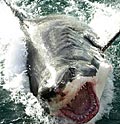
Australia’s eighth shark attack in a year, the mauling of a surfer by a 13-foot Great White, has prompted calls for the predators to be culled, angering environmentalists and tour operators. The attack on Jake Heron followed a fatal attack on Aug. 25, when 23-year-old marine biologist Jarrod Stehbens was killed near Adelaide.
Jake Heron’s three children looked on as the shark bit the cray fisherman’s surfboard in two and pulled him underwater near Port Lincoln, in South Australia state, on Sept. 4. Heron, 40, received 60 stitches to wounds in his arms, thigh and calf. Sharks kill an average of three people a year around Australia.
“It’s time they started controlling the number of sharks,” Heron said in an interview in Port Lincoln.
“We’re seeing more and more sharks out at sea and surfing has turned into a deadly lottery.”
The debate is pitting surfers and fishermen against environmentalists because the Great White was last year listed as an endangered species. Tour operators running lucrative dive-with- the-sharks trips from Australia’s south coast to northern Queensland are also opposed to culls. Tourism last year contributed 4.2 percent to Australia’s economy.
Great Whites are found in colder southern oceans and can grow to 25 feet, according to the Australian Shark Research Institute. Australia ranks behind South Africa for the number of shark-related fatalities, according to National Geographic.
Tour operators, including Andrew Fox, said so-called cage diving, where someone is lowered underwater in a cage to see the sharks, hadn’t caused extra attacks. Fox’s Rodney Fox Shark Experience operates from Adelaide in South Australia.
Tourist Attraction
“Sharks are a great attraction,” Fox said in an interview from Port Lincoln.
“We definitely don’t make the Great White sharks overcome any natural fear of humans.”
The Australian government in 2004 listed the Great White as an endangered species and it is protected in Australian waters as a vulnerable species. Sharks, sometimes referred to as ‘the living fossil,’ have existed in the oceans for some 400 million years.
Fox blames fish offal from tuna operators for increasing the number of Great Whites. Australia exported A$85 million of tuna last year, mainly to Japan, which leads the world in fish consumption, eating an average of 65.6 kilograms of seafood annually.
The International Commission for the Conservation of Atlantic Tuna in November approved the first international ban on shark finning to counter the slaughter of sharks around the world to feed the growing market for shark fin soup in Asia.
Annual Harvest
As many as 100 million sharks may be killed annually for food and sport after being snagged in fishing nets, said R. Aidan Martin, director of ReefQuest Centre for Shark Research in Vancouver. Japan takes the most sharks, averaging 65,000 tons a year, or equal to the tonnage displaced by an average cruise ship.
The price of a bowl of shark fin soup can be as much as $600, said Ralph S. Collier, president of the Shark Research Committee in Canoga Park, California. Shark finning consists of hacking the fin from the fish and then throwing the still living shark back into the water where it will suffocate because it can’t swim, he said.
Di Dennis, manager of the Port Lincoln Visitor Center, said sharks were a tourist attraction. Dennis said Great White jaws, teeth and fins were also a lucrative trophy business. As much as A$50,000 was paid for great white jaws in South Africa, according to the federal government.
“Tourists come here and expect to stand on the beach and see the sharks just paddling about in the ocean,” Dennis said in an interview from Port Lincoln.
“It’s quite an industry here, although you have to spend as long as four or five days out at sea looking for them.”











Social Profiles